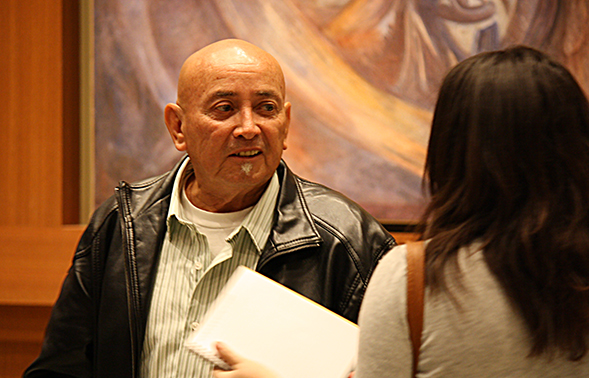Looking at Walls, Seeing Murals
SDSU shares a connection to Chicano Parks historic landmark designation.

What may be lesser known is the aesthetic contributions of two San Diego State University alumni, students in the late 1960s and early ’70s, who helped create the park's spectacularly vivid murals. Two examples of their work from that era, preserved and currently displayed on campus, directly tie the university to the newly designated historic site that began generating headlines in 1970.
That was the time when members of the Latino community occupied the land under the approach ramps of the Coronado Bridge. During the late ’60s, construction of the bridge had segmented the Barrio Logan neighborhood, displacing thousands of residents and local businesses.
In response to plans by the California Highway Patrol to build a substation on land beneath the bridge ramps, neighbors became activists who occupied the property, creating a community park. The concrete access ramps and bridge supports were viewed by community artists as giant canvases for murals depicting Mexican and Chicano history and culture.
Putting something out there
Among those artists was Guillermo Aranda, a former studio art major who studies painting and sculpture at SDSU between 1968 and 1970. He was among the first and most prolific of the many muralists who artistically expressed social, political and cultural views beneath the bridge.Reached by phone earlier this month at his home near Salinas, California, Aranda said he was excited to learn that the images he had helped create are now part of a National Historic Landmark. The 72-year-old artist said the designation was something he could never have imagined more than 40 years ago as he worked alongside community members of all ages applying various shades of vibrant colors to grey concrete.
“At that time I think we were just a bunch of angry, frustrated Chicanos wanting to say something, put something out there and not really knowing what,” Aranda said. “We had no idea what would become of all that work."
“Painting on everything we could”
Aranda’s introduction to mural painting had begun in the fall of 1969, when he and fellow artist Ruben DeAnda helped acclaimed Mexico City muralist Gilberto Ramirez paint a mural on the wall of Montezuma Lounge in the former Aztec Center. The Mural Triptico, as it was called, represented the evolution of the Chicano Movement."It talked about our struggle, our search for ourselves, our history, our culture,” Aranda said. “To us, the mural at San Diego State brought out the truth of the (Spanish) conquest, colonization, the separation of the land being divided, and at the same time talked about our hopes and our dreams for a better future. It was the same thing we were looking for when we were painting on those walls at Chicano Park.”
Aranda said his experience working on SDSU’s Mural Triptico with Ramirez had redefined, for him, the very meaning of art.
“Prior to that, my concept of art was very limited, but after working with Gilberto I began looking at walls and just envisioning beautiful murals on them,” Aranda said.
“All of a sudden, my whole world of art had changed. We were painting on everything we could.”
SDSU at the center of change
Today, the mural that Aranda describes as his “place of birth” hangs in the Conrad Prebys Aztec Student Union’s Montezuma Hall. It was rescued and restored when the old Aztec Center was razed, then rededicated in a March 2014 ceremony.SDSU anthropology professor Seth Mallios, who led the effort to preserve the Mural Triptico, said the piece exemplifies SDSU’s role in the Chicano Movement of the ’60s and ’70s. In addition to the muralists who were honing their skills on campus, SDSU also established what would become the first Chicano Studies program in the California State University system.
“At that time, if you had to pick the top three gathering places in San Diego where change was happening in Chicano history, culture and art, you were talking about Chicano Park in Barrio Logan, the Centro Cultural de la Raza in Balboa Park (where Aranda became chair of the Latino arts group Toltecas de Aztlán and painted his second major mural, La Dualidad), and San Diego State, where it all came together,” Mallios said.
An incredible, incredible artist
A second campus mural tying SDSU to the historic landmark murals of Chicano Park is the whimsical Rock ‘n’ Roll Mural now displayed on the third floor of Love Library. Originally painted on a block wall near the stage entrance to the legendary music venue, The Backdoor, in the old Aztec Center, it too was saved from the center's 2011 demolition and restored.The mural was completed by SDSU alumnus and art instructor Arturo Roman (’74) and his nine students in January 1976 as part of a Mexican-American Studies mural art class. Like Aranda, Roman helped paint some of the murals in Chicano Park.
“I really enjoyed working with him,” Aranda said of Roman, who left SDSU to become a Hollywood animator. “His work was dynamic. He was a natural. When he painted, his work was outstanding. He was just an incredible, incredible artist.”
An exciting time
In 2012, Aranda returned to Chicano Park to help restore some of the murals he helped create. He still paints on walls, teaching children about murals and instructing a class of inmates at a state penitentiary.He also fondly recalls his time as a student at SDSU where a master muralist introduced him to an unfamiliar art form.
"That initiated me into the mural world,” he recalled. “It was an exciting time there at San Diego State and at Chicano Park.
“I carry a lot of things from San Diego State and all of them fantastic: Beautiful memories. Beautiful experiences."



